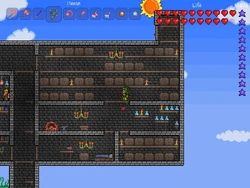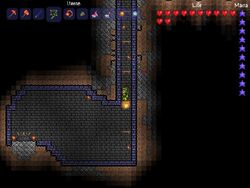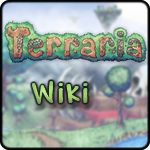Umbreonzangoose (talk | contribs) m (Picksaw link.) |
|||
| Line 102: | Line 102: | ||
===Actuator Door=== |
===Actuator Door=== |
||
| − | By using actuators and Grey, Brown, Blue or Lihzahrd [[pressure plate]]s, you can create a player only door that doesn't even require you to use your mouse. Setup the door as you would an active stone/actuator door and because Grey, Brown, Blue or Lihzahrd [[pressure plate]]s can only be activated by the player |
+ | By using actuators and Grey, Brown, Blue or Lihzahrd [[pressure plate]]s, you can create a player only door that doesn't even require you to use your mouse. Setup the door as you would an active stone/actuator door and because Grey, Brown, Blue or Lihzahrd [[pressure plate]]s can only be activated by the player. No mobs are able to enter (or escape). Also using hellstone for the door creates a great defence as it will provide (slow) damage for you. You can provide defense using super dart traps and spiky ball traps after you've gotten the [[Picksaw]]. |
{{guides}} |
{{guides}} |
||
Revision as of 02:58, 7 March 2014
Bases are generally used as safe havens where the player can craft and organize their Inventories in relative peace. A well-enclosed area with NPCs nearby to decrease enemy spawn rates is helpful. Most bases are composed of abundant block types like Wood or Stone at first, but by the midgame players should have access to better types of Bricks. It is recommended that you use doors inside, for it to count as a home, but have some form of blocking doors or defending outside, such as dart traps or active stone block wired to appear when you hit a switch. (As of Terraria 1.2, you can also use an actuator to make any type of block you want non-solid and solid again.)
Houses
- See also House.

A simple House with several early NPCs.
A somewhat complex Base with a Crafting station and some NPCs.
A House is an enclosed area fitting certain requirements that will house an NPC, but as multiple Houses can be connected by sharing the same walls, floors, ceilings, and Doors, the individual NPC "Houses" usually become rooms within a larger building.
As NPCs are vulnerable to enemies, this should generally be one of the most secure places in a base. Keeping the NPC rooms off of the ground floor will prevent deaths from Wraiths once hardmode is enabled. Some players may not bother since NPCs respawn fairly quickly.
One tactic to use is to build your houses facing each other, with Wood Platforms as doors. Then cover the space between the houses with an easily destroyed block like dirt or ash.
Bedroom
- See also Bed.

Typical storage, bedroom, and crafting area.
The player's own room within the larger structure should contain a Bed, which will serve as their spawn point. If the player has a Magic Mirror, this is where they will teleport to when using it. It is better to spawn and teleport to a safe and enclosed room in your home, rather than somewhere outside in the open. Also, another useful tip is to keep your Nurse near your spawn point, so you can heal when recovering from death.
- Useful tip: you can have multiple spawn points set up by building a base away from the original spawn point, using a bed as normal, but having at least a small portion of the structure made of active stone wall. With a flick of a switch, it's no longer a valid house, and thus resets the spawn point to the original point. Hitting the switch again makes it a valid structure again, without the need to reset the spawn point. If you have a lot of money, you can wire a small world up so that you can hit a switch at the original spawn point too. Great for quick travel to necessary places. There is a limit on how far a switch can activate an object, so this also doesn't work really well for very long distances. Use mainly on small worlds.
Crafting area
- See also: Guide:Crafting 101#Complete station.

Safely walled-in Demon Altar.
Having a centralized crafting area can keep things more organized. These items altogether probably warrant their own room. Keeping a Chest or two next to your crafting area is an efficient way to store and access your crafting materials quickly. The crafting stations are:
- Workbench, Cactus Work Bench, Mushroom Work Bench, OR Bone Work Bench
- Anvil OR Mythril Anvil
- Furnace, Hellforge, Titanium Forge, OR Adamantite Forge
- Alchemy Station
- Chair combined with a Table
- Loom
- Cooking Pot
- Sawmill
- Demon Altar (Cannot be moved or placed. House must be built around one of them. See picture)
- Water (For crafting Bottled Water)
- Honey (For crafting Bottled Honey)
- Tinkerer's Workshop
- Bookcase
Note that putting all crafting stations together has the downside of forcing the player to scroll through every potential crafting option to find the one that they need. Arranging the stations in a logical manner around your home may end up being more convenient.
Storage
Storage is achieved through the use of Storage items like the Chest. Storage is necessary given the amount of items that can be collected. Using a variety of different containers can make a storage area more navigable, as can using decorative items, statues, signs, or renaming the containers. Usually players put similar types of items into the same chest(s). Some players may even wish to integrate their crafting area to provide a sort of structure.
Players may wish to organize their storage items the same way between all worlds so that they don't have to remember a new pattern for each one.
One feature added, is when you open up a chest there is a quick stack option that will allow all inventory that you carry to be added with likewise inventory of the chest. Note: If a stack of identical items reaches maximum stack they will not continue to be added to the chest in a separate stack.
Garden
- See also: Guide:Gardening.
A dedicated garden can keep the player supplied with a steady variety of potions. Mushrooms and herbs can both be systematically produced and gathered, providing a considerable power boost to the prepared player.
Roof Access
Often a minor consideration, but a player that spends a fair amount of time in a large base has a good chance that Fallen Stars will accumulate on the roof overnight. The player may consider adding access to the flat roof along its length to grab these. Depending on the layout and size of the base, a player may be able to simply jump to the ceiling from rooms inside their base, and the star will pass through the ceiling to the player.
Teleporter Room
A Teleporter Room may be useful for late-game players who need to get to far away outposts quickly. Setting one up, however, will take a long time and will be very expensive to build considering the current price of Wire in-game and the distances that need to be covered to reach places like the Dungeon and The Underworld.
Outposts
There are two basic categories of outposts. You can build an outpost upon being ready to enter a particular biome for a first time, allowing rapid transit in and out. These outposts are minimalistic, usually just consisting of a bedroom and several chests. You can also build an outpost in a biome once you have already progressed past that point, to farm it for rare resources. These are typically more extensive, with large portions of the biome itself reconstructed to suit the player's needs. The entire creation of an outpost has been radically improved with the introduction of the Teleporter in 1.2, as players can now get to any outpost virtually instantly.
The Underworld
The Underworld has valuable resources not found elsewhere, so having an outpost there is valuable once you have progressed to that point. Players often construct Hellevators to provide easy access to the Underworld. Demons can be farmed for the Demon Scythe. Fire Imps can be farmed for the Plumber's Hat. Creating an open area with wooden platforms can help facilitate the rapid farming of these creatures.
Jungle
Placing an outpost in the Jungle allows the farming of a variety of resources. Jungles naturally spawn trees for wood; Piranha drop the Robot Hat, the underground variants can provide Vines, Jungle Spores, and Stingers. Players may also gather Jungle Rose, Nature's Gift, and simple Jungle Grass Seed. An artificial jungle may also be created for a more controlled environment.
Desert
Desert biomes allow the farming of Waterleaf, Cactus and Antlion Mandible. Hallowed and corrupt variants allow farming for the Dao of Pow. A large flat area is ideal.
Floating Island
Farming Harpies for feathers and Wyvern for Soul of Flight necessitates an accessible platform high in the sky. Players can also use an existing Floating Island for this purpose. An arena-style area with wooden platforms makes the fights easier.
Snow Biome
The snow biome does not currently have an exclusive resource other than the snow itself, so building an outpost here has no practical purpose. However, players may wish to build here anyway to make use of their Candy Cane Blocks. Players should also take note that this biome can't be taken over by the corruption or hallow.(this has been changed in update 1.2 snow biomes can now be corrupted making the ice purple)
Ocean
An ocean outpost is one of the more useful options, good for farming valuable Shark Fin and Coral. The easiest method is to simply build on the coast. Dedicated players with good swimming equipment can build an underwater base by using pumps to remove the water from their structures. Players may also wish to place underwater light sources.
If you want to do something different, try digging a mini-mineshaft just until you bypass all the sand. Dig a horizontal tunnel 2 tiles long and dig up 3 blocks. (Be careful of the sand... Remember it is affected by gravity. Once it gets in your tunnel you can't get it out without flooding the whole base.) Once you reach this point dig 2-3 blocks across (horizontally) from the highest point of your tunnel (3-4 blocks high, if you're doing it right) Then dig a mineshaft down. If you did it right you can now make a DRY underground/ underwater base.
Another method, for quick trips to the ocean to collect loot from monsters and chests, is to extend a platform out over the ocean and then use ropes to reach the bottom of the ocean, then travel up and down it to avoid drowning safely, and possibly stylize your platform as a pirate ship, if you so will.
Corruption
A base in the corruption allows the player to farm Vile Mushroom and Rotten Chunk, as well as providing a reliable location to summon the Eater of Worlds. The more valuable treasures lay deep underground; Cursed Flame and Soul of Night are both quite valuable. To capitalize on this, players may wish to clear out an area underground and connect it to their Corruption base. Advanced players may wish to build an ominous, glowing citadel of Demonite Brick.
Hallow
A base in the hallow can provide Pixie Dust and Unicorn Horns. A large, flat area is best for gathering these. Underground hallow can provide Crystal Shard and Soul of Light. Several long, straight tunnels make gathering Crystal Shards faster. Players wishing to make a base that melds with the environment may want to build with Pearlstone.
Base Defense
- See also Guide: Base Defense, and Guide:Defending against events.
Player-made structures do not come with guarantees against the local fauna or events. With this in mind, it is a good idea to prepare defenses against a variety of possible scenarios. How much effort to be invested depends entirely on the player; for example, having monsters wandering around plant farms may be no big deal but many would prefer their NPC areas to be protected.
Skybridge
A Meteorite crash can gouge out a huge chunk of terrain and this can be catastrophic if a direct hit occurred on a base. To protect against this a Skybridge can be built over the top of the structure to intercept the possible paths of falling meteors. When a meteorite does crash into this bridge it will change the blocks in the affected sections to Meteorite and create a hole in your skybridge. It is advisable to patrol the skybridge occasionally to check whether it needs repairing. (This is also a good way to "farm" meteorites in a controlled way).
Floating Base
Structures do not actually have to rest on surfaces, gravity notwithstanding. Once built, the terrain surrounding the base can be dug out to create a virtual moat around it, preventing easy access by most monsters. The Guide: Base Defense article goes into this in more detail. To build a floating base, get a stack of dirt or any other material not affected by gravity, and build straight up. You want to build high enough of the ground that no enemies can get to you, but low enough that Wyverns don't spawn late-game. When you are high enough, start building wood in a horizontal line. Place rope on one of the sides so that you can get down. Destroy the line of dirt or other blocks up to your flat line in the air. Now, just go back up your rope and start building in your sky city! This is best done in large worlds, since you can get pretty high off the ground without summoning Wyvern.
A compact floating house with several basic amenities.
Actuator Door
By using actuators and Grey, Brown, Blue or Lihzahrd pressure plates, you can create a player only door that doesn't even require you to use your mouse. Setup the door as you would an active stone/actuator door and because Grey, Brown, Blue or Lihzahrd pressure plates can only be activated by the player. No mobs are able to enter (or escape). Also using hellstone for the door creates a great defence as it will provide (slow) damage for you. You can provide defense using super dart traps and spiky ball traps after you've gotten the Picksaw.
